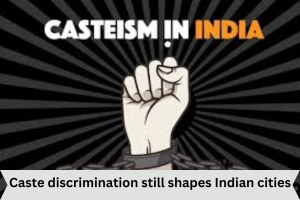ForumIAS announcing GS Foundation Program for UPSC CSE 2025-26 from 19 April. Click Here for more information.
Source: The post caste discrimination still shapes Indian cities has been created, based on the article “Urbanisation, no liberating force for Dalits” published in “The Hindu” on 15th April 2024.
UPSC Syllabus Topic: GS Paper-1-society-Salient features of Indian Society
News: The article discusses how caste discrimination still shapes Indian cities, despite urbanization offering a potential escape from traditional caste oppression. Caste discrimination still shapes Indian cities
What were the views of Gandhi and B.R. Ambedkar on the Indian village?
Gandhi’s View: Gandhi viewed Indian villages as self-reliant and equitable communities. He saw villages as centers of non-violent order. He advocated for decentralization of power through Gram Swaraj, believing it would lead to a just society.
Ambedkar’s View: Ambedkar rejected village life, seeing it as the foundation of the Hindu caste order. He described villages as “the working plant of the Hindu social order.” He Opposed the idea of autonomous village units in the Constituent Assembly, relieved when it was rejected.
What was Ambedkar’s view on urbanization?
Ambedkar’s Positive View on Urbanization:
Viewed cities as potential spaces for Dalit liberation from caste oppression.
Believed that the anonymity of urban life could help shift from a caste-based to a class-based order.
Challenges Observed in Urban Settings:
Despite opportunities, Ambedkar noted caste’s adaptation in cities, affecting housing and employment.
Cited his own struggle to find a house in Baroda as an example of persistent caste barriers.
How is segregation evident in Indian cities?
Segregation in Housing: A 2021 consumer survey revealed dietary habits (like eating non-vegetarian food) as a major factor in rental housing decisions, reflecting caste-based preferences.
Policy-Driven Segregation: State policies, such as Uttar Pradesh’s 2017 meat shop regulations near religious places, and Gujarat’s ban on street food sales on main roads in 2021, enforce segregation influenced by caste.
Impact on Public Services: Research indicates that Dalits and Muslims have the poorest access to municipal infrastructure like clean drinking water and are predominantly found in sacrifice zones near severe environmental pollution sources like landfills.
Question for practice
Discuss the differing views of Gandhi and B.R. Ambedkar on Indian villages and their perspectives on urbanization’s potential impact on caste oppression.





